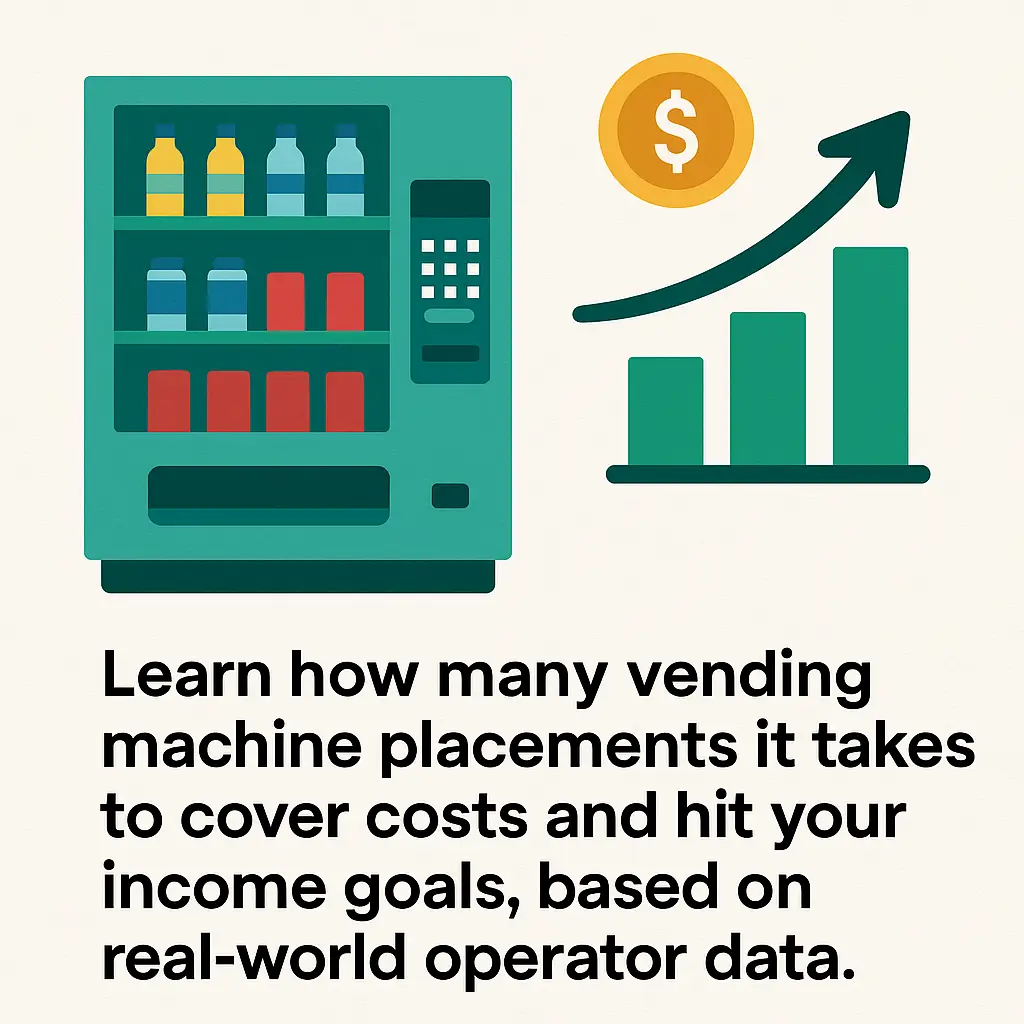How Many Locations Do You Need to Be Profitable?
Learn how many vending machine placements it takes to cover costs and hit your income goals, based on real-world operator data.
Back to Vending Machine Locators ResourcesLearn how many vending machine placements it takes to cover costs and hit your income goals, based on real-world operator data.
Back to Vending Machine Locators ResourcesStart your 30-day free trial and get instant SMS and email alerts whenever a local business needs vending service. These are real location leads to help you grow your route — you decide which ones to buy, no obligations or contracts.
![]() Break-even usually occurs after 5–10 well-performing locations
Break-even usually occurs after 5–10 well-performing locations
![]() Location type affects volume, margins, and restock frequency
Location type affects volume, margins, and restock frequency
![]() Route density cuts gas and service time, boosting profit
Route density cuts gas and service time, boosting profit
30 days free, then $39 / month.
No Commitment. Cancel Anytime.

One of the most common questions for new vending operators is: how many locations do you realistically need to be profitable? The answer depends on a mix of machine types, product mix, operational costs, and the quality of your placements, but some general benchmarks can help guide early decisions.
Most operators find that a single vending machine generates $200 to $400 per month in gross revenue. Using a conservative range, that means five machines could generate $1,000 to $2,000 monthly. After deducting product costs (often 40-50%), fuel, maintenance, and restocking labor — net profit per machine may range from $50 to $150 per month.
At that pace, reaching profitability usually requires 7–10 reliable locations to cover startup costs such as machines, product inventory, vehicle costs, and any locator fees. Operators who use combo machines or glass-front units in high-traffic locations can break even faster.
Your breakeven point also depends on how you structure your route. A tight, local route means less time on the road and lower fuel costs, which significantly boosts margins. On the flip side, a few low-traffic or poorly performing machines can drag down your ROI and delay payback time.
Another factor? How hands-on you're willing to be. Solo operators who handle stocking, repairs, and collections themselves can operate leaner. Outsourcing these tasks can speed up growth, but raises your monthly overhead.
As your experience grows, you’ll also get better at spotting underperforming locations and optimizing your machines to boost sales — whether that’s adjusting snack options, swapping outdated equipment, or upselling through smart vending tech.
If you're still new to the business, learning about efficiency tips for solo operators or reviewing advice on how to maintain your machines can help you keep profitability within reach.
Vending Exchange connects vending operators with real businesses actively looking for vending services—including traditional machines, AI coolers, and office coffee. Get instant SMS and email alerts when new opportunities are available in your area. No contracts or monthly fees—just buy the leads you want. Start your free 30-day trial today and grow your vending business on your terms.
You're profitable when monthly income exceeds all recurring costs including product, fuel, maintenance, machine payment, and taxes.
A single machine often earns $200–$400/month in gross revenue, depending on location and traffic.
Startup costs include machine purchase or lease, initial inventory, vehicle use, insurance, and optional locator services.
Not necessarily—5–10 machines in good locations can cover costs and generate part-time-level income.
Location quality, traffic volume, product pricing, refill frequency, and machine type all affect your earnings.
Depending on your investment and sales volume, it usually takes 6–12 months to break even.
Track gross revenue per machine, product cost percentage, fuel expenses, repair costs, and monthly net profit.
Yes. Higher-margin items or bestsellers like energy drinks and snacks can quickly increase profitability.
Yes, when those few locations have high sales and low servicing costs, especially with multi-unit placements.
Early reinvestment into better placements or upgraded machines can lead to more sustainable long-term growth.